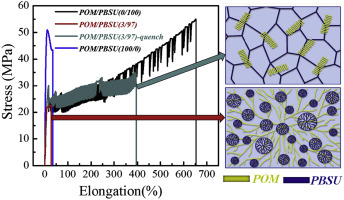Polymer ( IF 4.6 ) Pub Date : 2018-03-19 , DOI: 10.1016/j.polymer.2018.03.035 Jieqing Shen , Lijun Ye , Kangyuan Xie , Zhixiang Li , Qi Jiao , Zhenxian Chen , Yongjin Li

|
The structures and properties of melt-miscible poly(oxymethylene) (POM)/poly(butylene succinate) (PBSU) blends with low POM contents (≤10 wt%) have been investigated. As a rubbery semicrystalline polymer, neat PBSU is tough and highly ductile. However, when blended with small amounts of rigid POM, such as only 3 wt% POM, PBSU becomes very brittle. Both the elongation at break and strength of the blends were significantly lower than those of neat PBSU and POM. This unexpected brittleness of blends with the rubbery polymer as the dominant component has not been reported previously, as the major component is generally thought to dominate blend performance. Detailed investigation indicated that the brittleness of POM/PBSU blends with low POM contents originated from their unique morphologies. The POM/PBSU blends were miscible in the melt state. Cooling the crystalline/crystalline polymer blends led to POM first crystallization in the PBSU melts, followed by PBSU crystallization in the POM crystal-filled PBSU melts. In the PBSU-dominant blends, POM crystallized into weak (loose/coarse) crystal networks dispersed in the PBSU melts. These POM crystals nucleated PBSU crystallization through an epitaxial mechanism upon further cooling. Therefore, PBSU almost simultaneously crystallized on the edge of POM crystals and formed less connected PBSU crystals, resulting in blends that were weak and brittle due to the weak POM crystal networks and less connected PBSU spherulites. This mechanism was further proven by varying the POM crystallization conditions. The blends with low POM contents were ductile (similar to the mechanical behavior of neat PBSU) if the POM crystallized into tiny less connected crystals.
中文翻译:

出乎意料的脆性:二元聚合物共混物中的主要成分是否总是有意义?
研究了具有低POM含量(≤10 wt%)的可熔融混溶的聚甲醛(POM)/聚琥珀酸丁二酯(PBSU)共混物的结构和性能。作为橡胶状的半结晶聚合物,纯净的PBSU坚韧且高度延展。但是,当与少量的刚性POM(例如仅3 wt%的POM)混合时,PBSU变得非常脆。共混物的断裂伸长率和强度均显着低于纯PBSU和POM。以前没有报道过以橡胶状聚合物为主要成分的掺混料的这种意想不到的脆性,因为通常认为主要成分决定了掺混料的性能。详细的研究表明,低POM含量的POM / PBSU混合物的脆性源于其独特的形貌。POM / PBSU共混物在熔融状态下可混溶。冷却结晶/结晶聚合物共混物导致首先在PBSU熔体中结晶POM,然后在充满POM晶体的PBSU熔体中进行PBSU结晶。在PBSU为主的共混物中,POM结晶成分散在PBSU熔体中的弱(松散/粗大)晶体网络。这些POM晶体在进一步冷却时通过外延机制使PBSU结晶成核。因此,PBSU几乎同时在POM晶体的边缘上结晶,并形成较少连接的PBSU晶体,由于弱的POM晶体网络和较少连接的PBSU球晶,混合物变得脆弱而脆。通过改变POM的结晶条件进一步证明了这种机理。



























 京公网安备 11010802027423号
京公网安备 11010802027423号